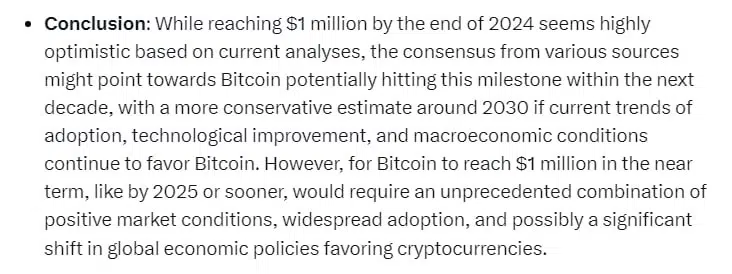Industry leaders and Grok AI, an artificial intelligence chatbot developed by xAI, have analyzed the price trajectory of Bitcoin toward reaching $1 million.
The analysis considers historical price trends, market sentiment, and macroeconomic factors. Notably, Bitcoin, currently priced at $58,527, would need to surge by 1,609% to hit the $1 million mark, resulting in a market capitalization of $19 trillion.
When $1 Million?
Historical data reveals that Bitcoin often experiences price surges following its halving events, which occur roughly every four years.
These events reduce the rate of new Bitcoin supply, typically resulting in a price increase 12-18 months later. Grok AI’s analysis suggests the next potential peak could occur around 2025, following the latest halving in April 2024.

These predictions align with the notion that Bitcoin’s price movements are often cyclical, driven by both supply constraints and growing institutional adoption.
However, while some projections indicate rapid growth in the coming years, others point to a longer timeline. Grok AI highlights predictions that place Bitcoin’s potential $1 million valuation around 2030 or later, contingent on factors such as inflationary pressure and continued interest from institutional investors.
This long-term view is based on the belief that Bitcoin will grow into a significant store of value, particularly as global financial systems face increasing challenges.
Insights from Industry Figures
Several experts have also weighed in on Bitcoin’s potential rise to $1 million. Mark Harvey, a Bitcoin enthusiast, expressed his belief that Bitcoin’s climb to this milestone would happen suddenly, potentially within a few months. He emphasizes that the price increase could occur when the market least expects it, encouraging investors to remain engaged.
On the other hand, Fred Krueger, an investor, suggests that the power law curve model points to a 2032 target for Bitcoin to reach $1 million. He anticipates a faster rise in the next three years, followed by a correction and a bear market before a more sustained rally toward $1 million by 2032.
Bitcoin 1 Million.
Not a question of "if". Question is "when".
Power law curve with n=5.8 suggests 2032 is a target.
So 8 years from now.I think its faster, followed by a longer reversion to the mean bear market.
So my best guess is 3 years from now, followed by a bear…
— Fred Krueger (@dotkrueger) March 2, 2024
Additionally, Willy Woo, a notable chartist, sees Bitcoin reaching $1 million within the next decade. According to his analysis, Bitcoin may become a reserve currency, limiting the power of central banks. This viewpoint reflects a belief that Bitcoin’s rise will have lasting effects on the global economy.
What a time to be alive.
BTC at $1m will happen easily in the next 10 years. Follow on impacts will be long lasting…
– BTC becomes a reserve currency
– a purge of central bank corruption
– wars become expensive
– younger leadership building for a future they will live in— Willy Woo (@woonomic) May 11, 2024
Rapid Rise Scenarios
Other figures foresee a more sudden ascent. Samson Mow, developer of AQUA Wallet, predicts Bitcoin could reach $1 million in a matter of days or weeks, driven by what he terms “max pain.”
In his thread, Mow believes the rapid surge would catch the market off guard, resulting in a wide array of challenges, from overwhelmed infrastructure to skyrocketing transaction fees.
Here’s why we’re going to $1M #Bitcoin in DAYS to WEEKS: it’s MAX PAIN pain for the most people.
Bitcoin has a way of doing what we least expect & in the most disruptive way. For example, at JAN3 we have many plans & meetings set for 2024. $1M BTC would derail everything.
🧵👇
— Samson Mow (@Excellion) January 9, 2024
Mow outlines how Lightning Network, a solution for faster Bitcoin transactions, might become inaccessible to new users due to high fees, and how institutions might struggle to adapt quickly to Bitcoin’s rise. He also highlights how nation-states and companies could miss opportunities to accumulate Bitcoin before it becomes more expensive.
 thecryptobasic.com
thecryptobasic.com
